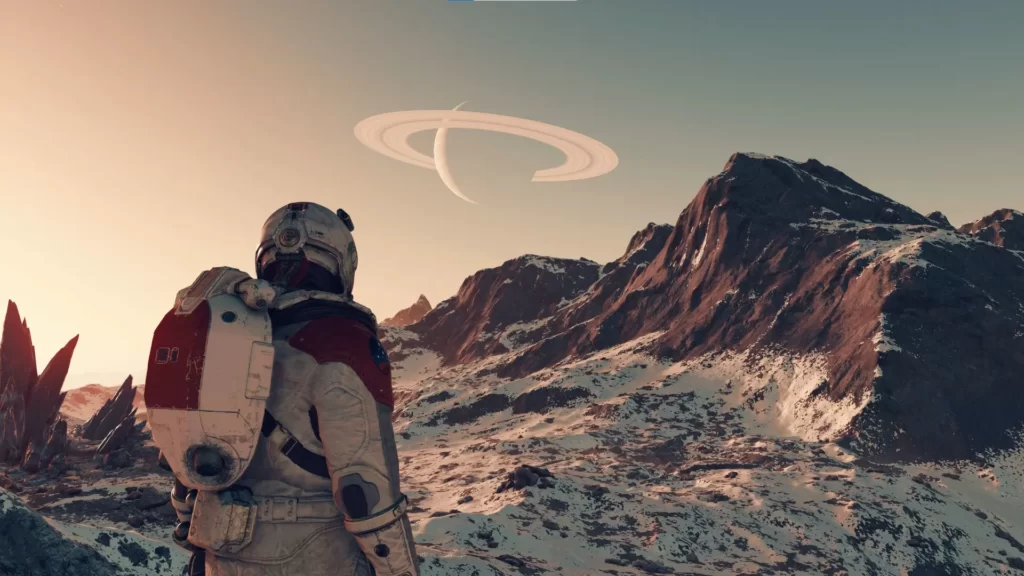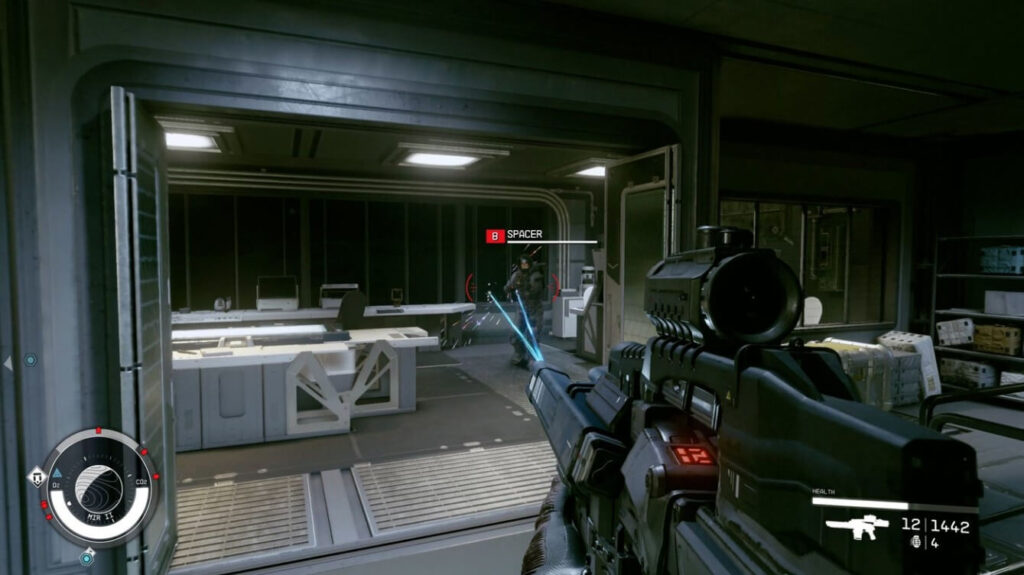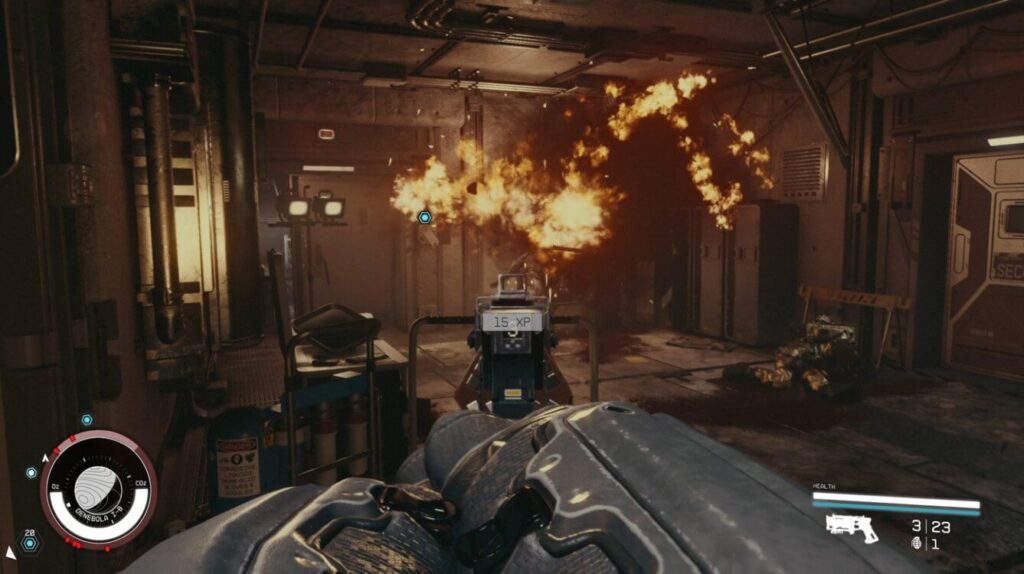Release Date : September 6, 2023
Developer(s) : Bethesda Game Studios
Publisher(s) : Bethesda Softworks
Platforms : Xbox Series X/S, PC
First announced at E3 2018 along with The Elder Scrolls VI, Starfield is a game with many challenges. First, from Bethesda’s side, to see if they’re still capable of delivering a brand new license on the same level as an Elder Scrolls or Fallout, and second from Microsoft’s side, which must offer Xbox gamers a strong exclusive icon, especially after Redfall’s disaster.
Apart from the industry’s concerns, Starfield is a dream come true for those who are constantly staring at the stars and dreaming of an RPG that brings that feeling of discovery and adventure into space. So, without further ado, here’s our review of this highly anticipated Space Opera.
Don’t worry, we won’t reveal any spoilers about the story or certain gameplay mechanics.
Table of Contents
An Era So Near and Yet So Far

You may have missed it if you haven’t followed all the information revealed in the game’s press releases, but Starfield has a particularly immersive lore you can relate to. Unlike other Space Operas, like Mass Effect, the game doesn’t take us into an extremely distant future with mad technological developments and well-established civilizations, as we’re often used to. It takes place in a future more or less close to our own, where humanity has colonized space, but has now, in 2330, lost the thrill of discovery.
As a new member of a group of explorers called Constellation, you begin your adventure into this huge network of systems. A new spirit of discovery motivated by the emergence of a cryptic artifact gives a strong sense of mystery to this journey. This red thread serves above all as a reference point for everything there is to explore outside the plot. Towns, NPCs, factions, companions… Bethesda hasn’t let us down when it comes to world-building, which puts Starfield in the class of games that reject ultra-direction and lengthy explanations, preferring to leave players as free as possible.
As a result, the early stages can be very confusing, with no real idea of where to start other than following the main quest. Possibilities and side quests are everywhere, but there are only a few cases where you feel the desire to discover more by reading all the digital diaries and NPC dialogues. The game’s bold combination of futurism and vintage sets the stage for this great journey into the unknown. A good impression, but one that needs to be qualified, since implementation can sometimes prove a little more complex.
Quality or Quantity?

Starfield features over 1,000 planets to explore, in a genre halfway between Skyrim and No Man’s Sky. We’re immersed in a fairly free and open RPG, with a pleasant dose of space simulation, including planet exploration and piloting. However, this ambitious mix comes with a few limitations that sometimes break the immersion. The most frustrating aspect of the game is the recurring need for fast travel to get around the galaxy. In a nutshell, taking off from a planet propels you into the orbit around it after a short loading time, then you open the galaxy map, select a star system, and finally, a planet to begin your journey.
Once on the chosen system, you fly in its orbit, but you have to go through another fast travel to land on the same planet, or to place yourself in an orbit around another planet in that system. Basically, Starfield’s biggest disappointment is its transitions and the lack of freedom in space. Still, the rendering is not catastrophic, since the possibility of wandering around inside your own ship, and the take-off, docking, and hyperspace leap sequences all serve to give you a real sense of space. The same goes for the music, which is discreet in general, but emphasizes ambiance in particular, with big increases in volume during epic moments.

Then we come to the exploration system within a planet. Bethesda announced quite early on that, of the 1,000 planets that can be explored, only a hundred or so are actually suitable for living beings. This means that Bethesda’s unique content is spread across a huge galaxy, with many planets having recurring points of interest that are randomly arranged when you land in a given area. Note that these environments are not procedural generations, but have been designated by the developers. You won’t be wandering around a planet for several hours, but instead visiting several biomes, studying the flora and fauna, gathering materials, and exploring abandoned outposts filled with enemies.
Ground exploration is a different story. Basically, you can land wherever you like on a planet (and experience different biomes). This will create a landing point that will form a sort of closed exploration dome around it. You can have up to 5 landing points on a single planet, but these domes are not linked to each other except by fast travel. You’ll never run into an invisible wall while you’re roaming around.
This is not a bad idea, nor is it a way of putting a lot of empty space around just for show, because the “unpublished” content is still extremely rich. Whether you like it or not, you’re going to be moving around a lot, and this structure gives you plenty of material for your adventures. In our 110 hours of gameplay, intensive exploration of “empty” planets should barely account for 10% of our time, and it’s certainly worth the effort.
Creativity Reaching for the Stars

Microsoft and Bethesda made no secret of it, Starfield is a big invitation to modders. The potential is huge, but there are already solid foundations on which to express your creativity. Housing is present, but the main focus is around outpost creation, which lets you build customized bases on any planet. This can be a home, a resource farm, a place to store what you gather on your adventures, or all of these things together. The possibilities are endless, and it’s this kind of scenario that justifies the countless number of planets.
Starfield is enough to make your head spin, and it’s impossible to do it all in one game, as the skill system forces you to diversify first, and then specialize. In some areas, you’ll only be scratching the surface unless you level up or start a New Game+. Unfortunately, we can’t go into too much detail here, to avoid spoiling any big surprises, but you should know that this system has been implemented brilliantly, and is definitely going to be the subject of debate.
To give you a concrete example, for us, it’s the shipbuilding that we found a little frustrating. The possibilities are amazing and the manipulations are very intuitive, but when we tried to replicate the Millennium Falcon or the Razor Crest, we realized that our oversight in this area was fatal. Returning to outposts, and spending skill points there will allow you to obtain more builds and create networks to link your outposts within and outside the same system.
Fortunately, character creation at the beginning of the game is well-designed enough to steer you towards what you prefer. This simply means that certain skills will be unlocked by default. Overall, Starfield is pretty complete in what it has to offer, including the RPG elements. It may be hard to be completely amazed by it after playing Baldur’s Gate 3, but it offers everything you could hope for when it comes to choices and solving problems. The skills you’ve unlocked and your links with the factions allow you to diversify your approaches and dialogue choices.
In Space, No One Will See You Glitch

Starfield is a pure Bethesda RPG. There’s a wealth of stories, quests, dungeons, and action. The title is very generous, and you can really feel the 8 years of development that have gone into it. You can find yourself in an abandoned site and experience an Alien-like situation, or infiltrate the world’s largest space piracy organization. But we still have the same system, based on generic missions that can be played infinitely.
The writing is top-notch and the situations are extremely varied. You can help your fellow humans as a good Samaritan, be a greedy opportunist, or play the role of a typical thug. You can also bring along your Constellation buddies, who all have interesting backgrounds, sometimes related to the plot or lore. You can assign them to your ship or outposts and use their talents to reinforce the ones you lack, or they can join you on your adventures and battles.
Bethesda has really taken care of the atmosphere in Starfield, and we can enjoy it to the full thanks to a refinement that finally counters the studio’s bad reputation for producing good games full of all kinds of bugs. The multiple postponements have been beneficial, and the space epic is almost flawless. The rare bugs we found were already listed in the patch note of the launch update. Even though our setup is pretty average, and just a hair below the recommended settings, the game runs like a charm.

The visual quality is excellent, reflecting Bethesda’s famous “Creation Engine” in a more advanced version. Sometimes you get the strange feeling of a combination of “old Bethesda” and “next-gen” graphics, but the improvements in lighting effects and textures are obvious. Whether in space or on a natural satellite, the panoramic views are absolutely breathtaking, with photo mode working perfectly. Each of the game’s three major cities has its own special charm, as well as many other interesting locations. However, there are a few weak points, particularly when it comes to facial expressions.
Moreover, our experience seems to confirm the reasons given by Bethesda when they announced that the Xbox versions would run at 30 FPS. The experience is fluid most of the time, with a more or less stable 60 FPS, but in certain areas, particularly within the major cities we’ve just mentioned, we’ve noticed framerate drops that give us an average rate between 30 and 40 FPS.
The Star of the Field?

When it comes to gameplay, Starfield embraces action like never before. The wide variety of weapons and combinations allows us to enjoy different gameplay styles, and even more so when you can mod them to suit your needs (here again, you’ll need to spend skill points to maximize your potential). Plus, the studio has taken full advantage of the absence of gravity and the jet-pack, opening up many new options for dynamic movement.
Other mechanics fall directly into the spoiler box, but let’s focus on the game’s biggest problems, which mainly appear in combat. First of all, the enemy AI is simply catastrophic. Either they’re just mindless cannon fodder, or they keep moving erratically for no reason. This is even more of a problem if you rely on stealth.
There’s also a serious balance and challenge issues. Having invested virtually no skill points in the combat tree, we thought it would be a struggle throughout the journey. But we never really felt threatened, despite having increased the difficulty level quickly. We really don’t understand how strong we are when we can easily defeat level 70 opponents even though we’re still at level 40.

We also get the impression that the type of damage we inflict (for example, energy damage is more effective against robots) doesn’t really matter. We also regret a lack of unique enemies or truly intimidating bosses. While we’re on the subject of bad points, it’s worth mentioning certain elements of the UI that are way too sober, such as the chaotic inventory and the scrolling menu shortcuts on the joystick.
To finish up with a positive note, the space battles are quite enjoyable. In the beginning, it can be a little difficult to master the mechanics and understand the importance of the ship mass, but you can have a lot of fun with dodging maneuvers or taking cover behind the asteroids. Here, balancing and difficulty make a little more sense, which makes shipbuilding more exciting.
Conclusion
With Starfield, Bethesda can now count on a strong new license alongside Fallout and The Elder Scrolls. The studio hasn’t lost its touch, and delivers a fresh RPG style that also maintains the unique touch we’ve always appreciated. The title succeeds in fully immersing you in its universe, and makes you feel the thrill of space exploration. There are some things to criticize, especially the combat, but the epic is so generous and complete that it immediately becomes a must-have. It also has a bright future with an upcoming expansion and mod support. Microsoft can also take comfort in knowing that it has a new key asset for Xbox.
